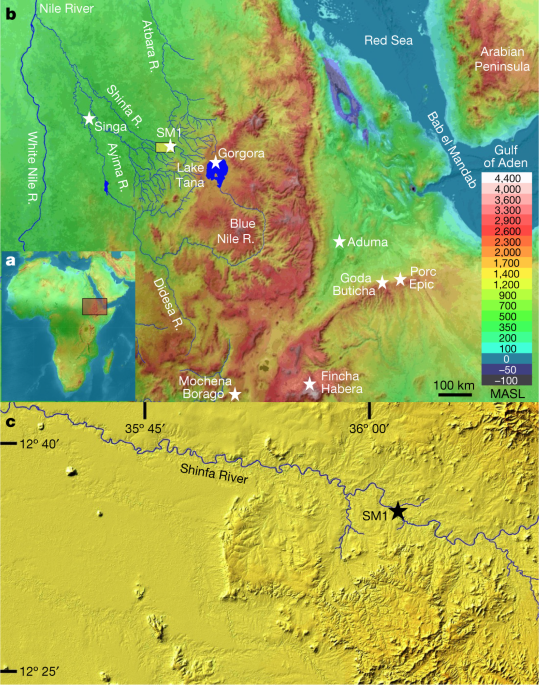Adaptive Foraging Behaviors in Horn of Africa During Toba Supereruption
Conceitos Básicos
Adaptive foraging strategies during arid conditions were crucial for human dispersal out of Africa.
Resumo
The content discusses the archaeological site Shinfa-Metema 1 in northwest Ethiopia, dating back to around 74,000 years ago. It reveals evidence of intensive riverine-based foraging with the adoption of the bow and arrow. The diet consisted of a variety of terrestrial and aquatic animals, showcasing adaptive behaviors to challenging climatic conditions during the Middle Stone Age. The presence of fish in waterholes during dry seasons suggests flexible adaptations and potential transformation of seasonal rivers into corridors for dispersal out of Africa.
Customize Summary
Rewrite with AI
Generate Citations
Translate Source
To Another Language
Generate MindMap
from source content
Visit Source
www.nature.com
Adaptive foraging behaviours in the Horn of Africa during Toba supereruption - Nature
Estatísticas
Most models suggest human dispersal occurred through green corridors created during humid periods.
Shinfa-Metema 1 site had Youngest Toba Tuff cryptotephra dated around 74,000 years ago.
Stable oxygen isotopes from fossil mammal teeth indicate high seasonal aridity at the site.
Citações
"Adaptive foraging along dry-season waterholes would have transformed seasonal rivers into ‘blue highway’ corridors."
"The behavioral flexibility required to survive seasonally arid conditions was crucial for human dispersal."
Principais Insights Extraídos De
by John Kappelm... às www.nature.com 03-20-2024
https://www.nature.com/articles/s41586-024-07208-3
Perguntas Mais Profundas
What other factors could have influenced human dispersal out of Africa?
Human dispersal out of Africa could have been influenced by various factors such as environmental changes, resource availability, competition with other hominin species, population pressures, and social dynamics. Environmental changes like shifts in climate patterns or the presence of green corridors during humid periods may have provided opportunities for migration. Additionally, the need to access new resources or escape competition with other hominin species could have driven populations to explore and move into new territories. Population pressures within Africa might also have pushed groups to seek out new areas for settlement. Social dynamics such as conflict or alliances among different groups could have played a role in shaping migration patterns as well.
How might the adoption of new technologies like the bow and arrow have impacted early human societies?
The adoption of new technologies like the bow and arrow would have had significant impacts on early human societies. Firstly, it would have improved hunting efficiency by allowing humans to hunt from a distance with greater accuracy, increasing their success rate in acquiring food resources. This would lead to more reliable access to protein-rich animal sources which are essential for survival and growth. The use of bows and arrows may also have enabled humans to defend themselves against predators or rival groups more effectively, enhancing their safety and security.
Moreover, the development of such advanced tools indicates cognitive advancements in terms of planning, innovation, and cooperation within these societies. Specialization in tool-making skills might emerge leading to social differentiation based on expertise. The introduction of this technology likely facilitated cultural exchange between different groups through trade or sharing knowledge about tool production techniques.
How do archaeological findings like those at Shinfa-Metema 1 contribute to our understanding of ancient human behaviors?
Archaeological findings at sites like Shinfa-Metema 1 provide valuable insights into ancient human behaviors by offering tangible evidence of past activities and adaptations under specific environmental conditions. In this case study specifically related to Toba supereruption period around 74,000 years ago in northwest Ethiopia reveals how early humans adapted their foraging strategies during challenging climatic conditions marked by high seasonal aridity.
The discovery that inhabitants engaged intensively in riverine-based foraging aided by innovative tools like bows and arrows sheds light on their ability to adapt flexibly according to changing circumstances - showcasing behavioral flexibility crucial for survival during harsh environments.
Furthermore, analysis using stable oxygen isotopes from fossil mammal teeth provides information about dietary preferences while abundance fish remains suggest exploitation strategies employed due shrinking waterholes during dry seasons revealing sophisticated resource management practices.
Overall these findings deepen our understanding regarding how ancient populations interacted with their environment demonstrating resilience creativity necessary thrive amidst adverse conditions ultimately influencing subsequent dispersals modern humans worldwide
0
